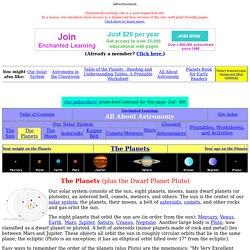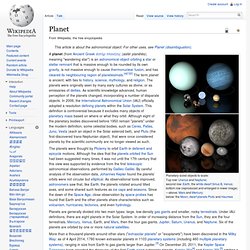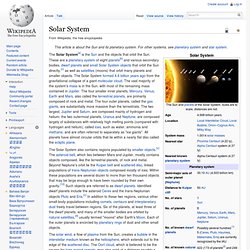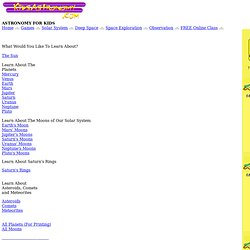

Planets - Zoom Astronomy. Advertisement.

EnchantedLearning.com is a user-supported site. As a bonus, site members have access to a banner-ad-free version of the site, with print-friendly pages.Click here to learn more. (Already a member? Click here.) The Planets (plus the Dwarf Planet Pluto) Our solar system consists of the sun, eight planets, moons, many dwarf planets (or plutoids), an asteroid belt, comets, meteors, and others. The eight planets that orbit the sun are (in order from the sun): Mercury, Venus, Earth, Mars, Jupiter, Saturn, Uranus, Neptune.
Easy ways to remember the order of the planets (plus Pluto) are the mnemonics: "My Very Excellent Mother Just Sent Us Nine Pizzas" and "My Very Easy Method Just Simplifies Us Naming Planets" The first letter of each of these words represents a planet - in the correct order. The largest planet is Jupiter. The inner planets are: Mercury, Venus, Earth, and Mars. Welcome to the Planets. : Planets. Planets: The planet count in our solar system has gone as high as 15 before new discoveries prompted a fine tuning of the definition of a planet.

The most recent change was in 2006 when scientists reclassified Pluto as a new kind of object - a dwarf planet. Dwarf Planets: This new class of worlds helps us categorize objects that orbit the Sun but aren't quite the same as the rocky planets and gas giants in our solar system. There could be hundreds more of these small worlds far out there waiting to be discovered. Moons: This count includes only the moons orbiting the eight planets in our solar system. Asteroids: New asteroids are discovered on an almost daily basis. Comets: Orbiting spacecraft such as SOHO have raised this tally in recent years by catching the comets as they plunge toward the Sun - and sometimes vaporize. Planet. The planets were thought by Ptolemy to orbit Earth in deferent and epicycle motions.

Although the idea that the planets orbited the Sun had been suggested many times, it was not until the 17th century that this view was supported by evidence from the first telescopic astronomical observations, performed by Galileo Galilei. By careful analysis of the observation data, Johannes Kepler found the planets' orbits were not circular but elliptical. As observational tools improved, astronomers saw that, like Earth, the planets rotated around tilted axes, and some shared such features as ice caps and seasons. Since the dawn of the Space Age, close observation by space probes has found that Earth and the other planets share characteristics such as volcanism, hurricanes, tectonics, and even hydrology. History Printed rendition of a geocentric cosmological model from Cosmographia, Antwerp, 1539 Babylon Greco-Roman astronomy India Medieval Muslim astronomy European Renaissance 19th century 20th century.
The Nine Planets Solar System Tour. Introduction. Solar System. Discovery and exploration Andreas Cellarius's illustration of the Copernican system, from the Harmonia Macrocosmica (1660) For many thousands of years, humanity, with a few notable exceptions, did not recognize the existence of the Solar System.

People believed Earth to be stationary at the centre of the universe and categorically different from the divine or ethereal objects that moved through the sky. Although the Greek philosopher Aristarchus of Samos had speculated on a heliocentric reordering of the cosmos,[11] Nicolaus Copernicus was the first to develop a mathematically predictive heliocentric system.[12] His 17th-century successors, Galileo Galilei, Johannes Kepler and Isaac Newton, developed an understanding of physics that led to the gradual acceptance of the idea that Earth moves around the Sun and that the planets are governed by the same physical laws that governed Earth. Additionally, the invention of the telescope led to the discovery of further planets and moons. The Solar System - Astronomy For Kids - KidsAstronomy.com. Our solar neighborhood is an exciting place.

The Solar System is full of planets, moons, asteroids, comets, minor planets, and many other exciting objects. Learn about Io, the explosive moon that orbits the planet Jupiter, or explore the gigantic canyons and deserts on Mars. What Is The Solar System? The Solar System is made up of all the planets that orbit our Sun.